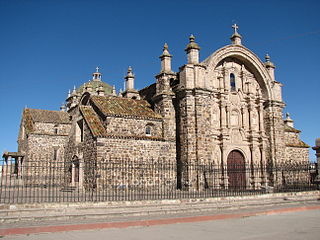| Pukarani | |
|---|---|
The village of Nicasio with Pukarani in the background | |
| Highest point | |
| Elevation | 4,301.9 m (14,114 ft) [1] |
| Coordinates | 15°14′28″S70°16′40″W / 15.24111°S 70.27778°W Coordinates: 15°14′28″S70°16′40″W / 15.24111°S 70.27778°W |
| Geography | |
| Location | Peru, Puno Region, Lampa Province |
| Parent range | Andes |
Pukarani (Aymara pukara fortress or a mountain of protection, [2] -ni a suffix to indicate ownership, "the one with a fortress", Hispanicized spelling Pucarani) is a mountain with an archaeological site of the same name in the Andes of Peru, about 4,301.9 m (14,114 ft) high. It is located in the Puno Region, Lampa Province, Nicasio District. [3]

Aymara is an Aymaran language spoken by the Aymara people of the Andes. It is one of only a handful of Native American languages with over one million speakers. Aymara, along with Spanish, is one of the official languages of Bolivia and parts of Peru. It is also spoken, to a much lesser extent, by some communities in northern Chile, where it is a recognized minority language.

Pukara is a defensive hilltop site or fortification built by the prehispanic and historic inhabitants of the central Andean area. In some cases, these sites acted as temporary fortified refuges during periods of increased conflict, while other sites show evidence for permanent occupation. Emerging as a major site type during the Late Intermediate Period, the pukara form was adopted in some areas by the Inca military in contested borderlands of the Inca Empire. The Spanish also referred to the Mapuche earthen forts built during the Arauco War in the 16th and 17th centuries by this term.
In linguistics, a suffix is an affix which is placed after the stem of a word. Common examples are case endings, which indicate the grammatical case of nouns or adjectives, and verb endings, which form the conjugation of verbs.
The archaeological site of Pukarani was declared a National Cultural Heritage by Resolución Directoral Nacional No. 79. [4] It lies north of the mountain and archaeological site of Intikancha.




